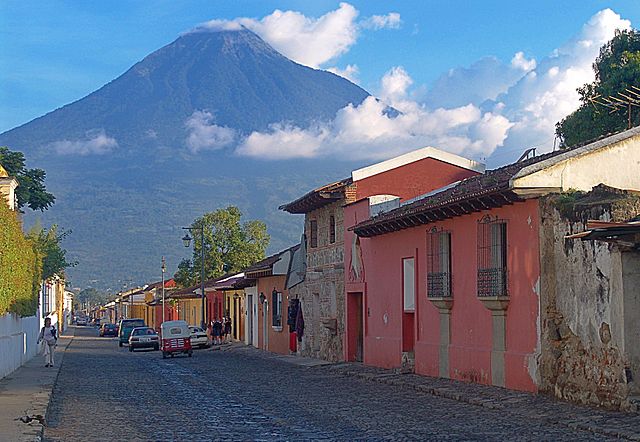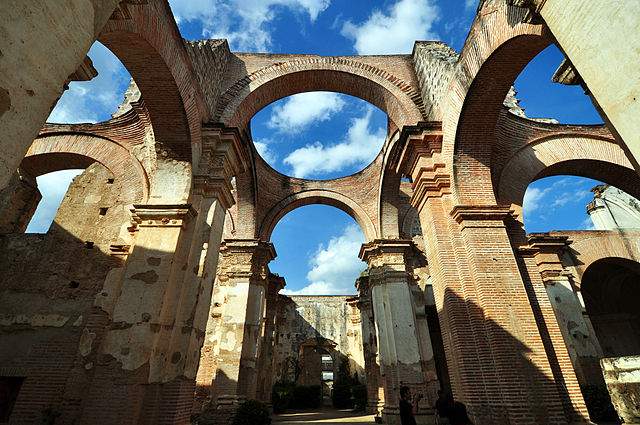The beautiful churches, centuries of ruins, and three surrounding volcanoes; the lack of traffic, honking, or gangs; a central square enclosed by columned arcades, shops, and restaurants; the massive colonial buildings; lush gardens, 80-degree weather year-round, and an incredibly diverse and inspired population—these attributes are probably what make Antigua one of Central America’s most popular destinations, both to visit and to expatriate.
In a country (Guatemala) plagued with violence and run by corruption, Antigua’s pastel buildings, cobblestone roads, and open-air plazas make for a very inviting respite. The traffic cops usher pedestrians across the street to the market. Unguarded coffee shops and cafes beckon customers rather than fear robbery, as is the case in the nearby capital. People stroll without checking over their shoulders. Options—from massage to ice cream to souvenirs—abound.
Ironically, all of these niceties are why many afternoons I’ve sat listening to travelers berate the place, disgusted with the gringo presence, appalled at the food options with their accompanying price ratios. Antigua, they like to say, is nothing like the rest of Guatemala, treating the former capital as if it were just another Cancun, the most frequent insult that of calling it Guatemala’s “Disneyland.” I’ve rarely come to the city’s defense, but all that’s about to change.

I go to Tikal to see Mayan pyramids in pristine jungle, and I’m happy not to find rotting piles of garbage or anemic street dogs there. I go to Semuc Champey to see crystal blue pools rather than polluted streams, lakes soiled from sewage and chemical runoff. I go to Antigua to see a well-preserved, amazing municipality, as opposed to, say, Guatemala City’s pollution, guns, and barbed wire. Since when do we travel to see the lowlights?
I find it odd that we, as travelers, celebrate first-world multi-cultural destinations like New York or London, but when a place like Antigua gets something funky going on, we treat it like a sham. It’s as if a third-world city isn’t allowed to attract foreign residents, keep its streets clean and light of traffic, as if real should equate to something less. Why shouldn’t Guatemala have some place that rises above the norm? After all, isn’t that what London and New York do?
Truthfully, that’s the cultural beauty of Antigua. It is real, just a real version of where modern Guatemalans want to be, more a melting pot of curious contributors than 100% Chapin. Still, Antigua’s streets are filled with Mayan women who are completely honest in their traditional dress. On the weekend, people flock from the capital to enjoy the city, because, like all those tourists and ex-pats, they recognize its worth. They have since before the first tourist got here.
What’s more is that Antigua hasn’t gone the way of Mexican resort beaches or US-sponsored malls. It’s full of small businesses, both locally and foreign-owned. For every McDonald’s (1), Subway (1), or Domino’s (1), there are ten or more unique restaurants to try. There is no Hilton or Best Western, no Applebee’s or Outback Steakhouse; no Starbuck’s or Dunkin’ Donuts. The place is original, and in that way, a real version of where many of us want to be.

Make no mistake, either, Antigua is not Disneyland. It doesn’t have roller coasters, and I’ve only occasionally seen people in cartoon costumes (usually to advertise for a pharmacy). The homeless people, while certainly caricature-like, are not in costume. The bracelets being hawked everywhere, while mass-produced, are most likely hand-made and someone’s livelihood. The Sesame Street sweatshirts sold in the street stalls are knock-off, unlicensed reproductions.
In reality, it’s a city twice wrecked by earthquakes, clinging to its cobblestone, dotted with crumbling facades. The buses, while brightly colored, are still of the chicken variety and often belch black smoke at pedestrians. In certain corners of the market, horrible chunks of fly-crusted meat sit unrefrigerated and awaiting purchase. Very little is wheel-chair accessible. Very little is idiot-proof. However, I can’t deny it lacks the danger and dirt that much of Guatemala has.
Consequently, it’s packed with tourists. Restaurants either tout traditional cuisine or fully embrace super-sized burgers and pizza. All bars seem to have half-day happy hours, and nearly every street has a hostel, souvenir shop, and travel agency. There’s the only bagel shop I’ve ever seen outside the US, so successful a second branch opened on the same street, and I’ve never seen such a concentration of ice cream parlors as the three blocks northwest of Parque Central.
Perhaps I have a sweet spot for Antigua because my first time living here found me in the reality of Guatemala City. I lived in Zone 10, an affluent area, but there were still murders (plural) on my street, horrible eruptions of car horn and muffler backfires in standstill traffic, and an armed guard stationed outside the bakery. I used to visit Antigua, like many from the capital, to escape certain daily realities. To miss that about the place is to miss the point: We all need solace.
So, as an ex-pat, as a non-resident of Antigua, and a traveler who rejects the harsh judgments put on the city, I invite you all the Central America’s tourist capital. Enjoy the views. Sip a licuado or coffee. Peruse the shops and spend some money. Sit in Parque Central for a session of people-watching, maybe soak in some sunshine as the fountain supplies a little mirage.

Here are some of my favorite haunts, places that, to me, are classic Antigua:
- Café No Se is a wicked bar, grabbing on to that dive persona, with grungy walls full of graffiti, little space, and live music. The best part, however, is the fake fridge door that leads into a mescal bar. John, the owner, also runs a Mescal distillery in Oaxaca, Mexico.
- The Bagel Barn could be the bagel place in any hip neighborhood in the US. It’s got that same feel, with eclectic cream cheeses and quirkily named sandwiches. It opens before anything else in the city and, thus, is the place to go for breakfast before catching a shuttle to somewhere new.
- Nimpot, for me, beats the tourist market. If you’ve traveled around enough to be tired of negotiating prices, or like me, sometimes are left feeling exploitive and cheap, Nimpot offers just about all of the market souvenirs (and more) for about the same as the lowball market price.
- Mono Loco is the independently-owned equivalent to a Chile’s, with hearty foreign-friendly cuisine and big screen TVs showing satellite sports. Prices and atmosphere, also, are more akin to those back home, but much of the clientele is local, so much so a new one is opening in Guate.
- Mercado de Artesanias – While I prefer shopping at the aforementioned Nimpot, it is pretty dazzling and definitely worth walking around. The Mayan materials—the hammocks, tablecloths, bags and juggling balls—make the place so colorful. It’s a lively experience in itself.
- La Escalonia is right on the outskirts of town and is a little bistro-style restaurant in front of a garden center. The food is on form, but the highlight of going there is sitting in or around the beautiful courtyard that is chocked full of exotic plants and unusual flowers.
- Panza Verde, meaning “green belly”, a reference to avocadoes, is a hotel and fine-dining restaurant that is the swank outing in town. A beautiful space if not for the faint of wallet, it’s a great place for spoiling yourself or the one you love. Sneak up to the roof for some nice vistas.
- Y Tu Pina Tambien is an indie-style coffee shop with nice, cheap fare and a lot of personality. For me, it’s one of the few businesses around that I feel right loitering in. It’s a bring-a-book, pick-up-a-magazine, or scribble-in-your-journal joint, with enough space to feel comfortable.
- Earth Lodge, which is actually 7 km outside of Antigua, is a locals’ favorite, and it’s literally easy to see why: Set 6,000 feet above sea level, the Lodge offers one of the most butterfly-inducing views of the three volcanoes. It’s also just a great laidback place to enjoy.
- Café Condessa, in Parque Central, is hidden through the backdoor of a book shop and offers a bit more Guatemalan-esque food, with tortillas and beans and all that good stuff. Plus, it has a great little hidden garden in the center of it and moves at a nice, leisurely pace.
Other than that, I would recommend a few Antigua-based magazines, which are free to pick up around town or view online. La Cuadra is not exactly a guide but has great sarcastic articles, often features something on the local goings-on, and has a good map of recommendations. All About Antigua Guatemala, a little spiral bound catalogue, is fantastic for getting you to all the sites and letting you know what tours and such are available. Que Pasa Magazine is the classic Antigua monthly and has great features about all things Guatemala.
To read more about traveling in Guatemala, check out the following articles and resources:
- Check out our Guatemala Indie Travel Guide
- Read 6 Ways to Have an Indie Travel Experience in Guatemala
- Read How to Plan an Extended Trip in Central America
- Catch a flight to Guatemala
- Search for hostels in Guatemala
Photo credits: chensiyuan, Hermann Luyken, ZackClark
